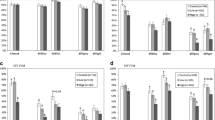Abstract
Purpose
The mouse embryo assay (MEA) is used to test media used for in vitrofertilization (IVF). Negative controls usually consist of previously tested media known to support growth of embryos to the blastocyst stage by 72 h. Often, no concurrent positive (toxic) controls are reported. Thus, any unusually hardy cohort of embryos may go undetected. Endotoxin was tested for its suitability as a positive control in the MEA.
Results
Female mice were stimulated with gonadotropins mated with males, and embryos flushed from their oviducts 36 h after HCG injection. Two-cell embryos were pooled and randomly distributed to culture dishes containing media without protein supplement. Endotoxin inhibited blastocyst growth beginning at 50 Μg/ml, with complete suppression of development at 5000 Μg/ml. With 500 Μg/ml endotoxin, an average of 34.8% of the embryos developed to the blastocyst stage for eight separate assays. The interassay coefficient of variation (CV) was 76%, while the intraassay CV was 9.4%. At 48 h the zona pellucida was absent from all of the embryos exposed to the endotoxin. A large difference was found between two lots of endotoxin with the same claimed potency.
Conclusions
These studies demonstrate the importance for inclusion of a well-defined positive control when performing the mouse embryo assay.
Similar content being viewed by others
References
Guidelines for human embryology and andrology laboratories. Fertil Steril 1992;58(1):1S–16S
Gerrity M: Legislative efforts affecting the reproductive biology laboratory. Curr Opin Obstet Gynecol 1993;5:623–629
Snyman E, Van der Merwe JV: Endotoxin-polluted medium in a human in vitro fertilization program. Fertil Steril 1986;46(2):273–276
Fishel S, Jackson P, Webster J, Faratian B: Endotoxins in culture medium for human in vitro fertilization. Fertil Steril 1988;49(1):108–111
Nagata Y, Yoshimitsu K, Shirakawa K: A quality control for the culture system using endotoxin assays in human in vitro fertilization and embryo transfer. Acta Obstet Gynaecol Japon 1993;45(3):220–226
Randall GW, Gantt PA: Preimplantation murine embryos are more resistant than human embryos to bacterial endotoxins. J in Vitro Fertil Embryo Transf 1990;7(5):280–282
Dumoulin JC, Menheere PP, Evers JL, Kleukers AP, Pieters MH, Bras M, Geraedts JP: The effects of endotoxins on gametes and preimplantation embryos cultured in vitro. Hum Reprod 1991;6(5):730–734
McDowell JS, Swanson RJ, Maloney M, Veeck L: Mouse embryo quality control for toxicity determination in the Norfolk in vitro fertilization program. J in Vitro Fertil Embryo Transf 1988;5(3):144–148
Scott LF, Sundaram SG, Smith S: The relevance and use of mouse embryo bioassays for quality control in an assisted reproductive technology program. Fertil Steril 1993;60(3):559–568
Montoro L, Subias E, Young P, Baccaro M, Swanson J, Sueldo C: Detection of endotoxin in human in vitro fertilization by the zona-free mouse embryo assay. Fertil Steril 1990;54(1):109–112
Fleetham JA, Pattinson HA, Mortimer D: The mouse embryo culture system: improving the sensitivity for use as a quality control assay for human in vitro fertilization. Fertil Steril 1993;59(1):192–196
Author information
Authors and Affiliations
Rights and permissions
About this article
Cite this article
Dubin, N.H., Bornstein, D.R. & Gong, Y. Use of endotoxin as a positive (toxic) control in the mouse embryo assay. J Assist Reprod Genet 12, 147–152 (1995). https://doi.org/10.1007/BF02211385
Received:
Accepted:
Issue Date:
DOI: https://doi.org/10.1007/BF02211385




